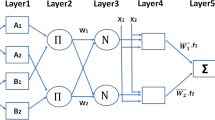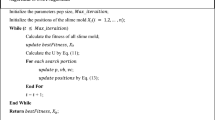Abstract
Engineering experience may be written in mathematical form by using adaptive network-based fuzzy inference system (ANFIS). In this article we propose a method to use engineering experience and build a model, which can be used as a systematic decision support tool for engineers dealing with new problems. Planning geotechnical investigations is based on experience, which are used to obtain optimal number of investigation points, field and laboratory tests. To achieve this objective we define minimum number of investigation points and several input parameters which could increase or decrease the number of investigation points. The expert’s evaluations were put in a table, from which we generate the basis of the system. The paper presents a concept for planning geotechnical investigation for buildings using ANFIS and practical examples show its usefulness.


Similar content being viewed by others
References
Baecher G, Christian JT (2003) Reliability and statistics in geotechnical engineering. Wiley, New York
Bezdec JC (1981) Pattern recognition with fuzzy objective function algorithms. Plenum Press, New York
Boissier D (2000) Décision et incomplétude. Rev Fr Géotech 93:81–92
Bond A, Harris A (2008) Decoding Eurocode 7. Taylor & Francis Group, London
Boumezerane D, Belkacemi S, Zlender B (2011) Fuzzy sets decision support system for geotechnical site soundings. Acta Geotechnica Slovenica 8(1):51–63
Cambefort H (1980) Géotechnique de l’Ingénieur, reconnaissance des sols. Eyrolles Editeur, Paris
Chuang PH (1995) Use of fuzzy sets for evaluating Shear strength of soils. Comput Geotech 17(4):425–446
Clayton CRI, Matthews MC, Simons NE (2005) Site investigation. Department of Civil Engineering, University of Surrey, Department of Civil Engineering
Dodagoudar GR, Venkatachalam G (2000) Reliability analysis of slopes using fuzzy sets theory. Comput Geotech 27:101–115
EN 1997-1 (2005) Geotechnical design - Part 1: General rules (Eurocode 7-1)
EN 1997-2 (2007) Geotechnical design—part 2: ground investigation and testing (Eurocode 7-2)
Fetz J, Jäger J et al (1999) Fuzzy models in geotechnical engineering and construction management. Comput Aided Civil Infrastruct Eng 14(2):93–106
Giasi CI, Masi P, Cherubini C (2003) Probabilistic and fuzzy reliability analysis of a sample slope near Aliano. Eng Geol 67:391–402
Hu Z, Chan CW, Huang GH (2003) A fuzzy expert system for site characterization. Expert Syst Appl 24(2003):123–131
Huang YT, Siller TJ (1997) Fuzzy representation and reasoning in geotechnical site characterization. Comput Geotech 21:65–86
Jang JR (1993) ANFIS: adaptive-network-based fuzzy inference system. IEEE Transactions on Systems, Man, and Cybernetics 23:665–685
Look BG (2007) Handbook of geotechnical investigation and design tables. Balkema Taylor & Francis Group, London
Magnan JP (2000) Quelques spécificités du problème des incertitudes en géotechnique. Rev Fr Géotech 93:3–9
Mamdani EH, Assilian S (1975) An experiment in linguistic synthesis with a fuzzy logic controller. Int J Man-Mach Stud 7:1–13
Nawari NO, Liang R (2000) Fuzzy-based approach for determination of characteristic values of measured geotechnical parameters. Can Geotech J 37:1131–1140
Romo MP, Garcia SR (2003) Neurofuzzy mapping of CPT values into soil dynamic properties. Soil Dyn Earthq Eng 23:473–482
Rumelhart DE, Hinton GE, Williams RJ (1986) Learning representations by back-propagating errors. Nature 323:533–536
Sabatini PJ et al (2002) Evaluation of soil and rock properties. Geotechnical Engineering Circular 5 (GEC5), Report No FHWA-IF-02-034, Federal Highway Administration, U.S. Department of Transportation
Santamarina JC, Chameau JL (1989) Limitations in decision making and system performance. J Perform Constr Facil 3:78–86
Schönhardt M, Witt KJ (2003) Adaptive ground modelling in geotechnical engineering. In: Proceedings of the international symposium on geotechnical measurements and modelling 23–25 September 2003, Balkema Publishers, Karlsruhe, Germany, pp 297–305
Strater NH, McKown AF (2002) Draft report on preliminary geotechnical studies, Proposed Beverly High School Building Addition, Beverly, Massachusetts. Haley & Aldrich Inc., Boston Massachusetts, file No. 28022-001
Sugeno M (1985) Industrial applications of fuzzy control. Elsevier Science Pub. Co, New York
Zadeh LA (1965) Fuzzy sets. Inf Control 8:338–353
Author information
Authors and Affiliations
Corresponding author
Rights and permissions
About this article
Cite this article
Žlender, B., Jelušič, P. & Boumezerane, D. Planning Geotechnical Investigation Using ANFIS. Geotech Geol Eng 30, 975–989 (2012). https://doi.org/10.1007/s10706-012-9520-7
Received:
Accepted:
Published:
Issue Date:
DOI: https://doi.org/10.1007/s10706-012-9520-7




